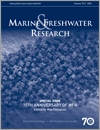
Marine and Freshwater Research
Volume 71 Number 1 2020
70th Anniversary of MFR
MF18372The environmental history of Australian rivers: a neglected field of opportunity?
Australia provides fertile ground for the preparation of environmental histories, but few have been written on the country’s rivers. This essay examines 10 case studies that demonstrate how rivers have influenced perceptions and attitudes of the Australian community over the past 200+ years.
MF18402Wise use: using ecological models to understand and manage aquatic ecosystems
Ecological models can be useful to understand natural ecosystems and inform their management, but are frequently untested. Deliberately testing models, particularly with new data, can avoid misleading findings arising from a lack of key data or inappropriate models. Useful models enable us to quantify human impacts on, and understand possible future outcomes for, aquatic ecosystems.
MF18386Resource fluctuation patterns influence emergent properties of phytoplankton assemblages and their resistance to harmful algal blooms
Harmful impacts to aquatic ecosystems have resulted from human population growth, watershed development and climate change, which include harmful algal blooms (HABs). This paper spotlights recent discoveries, showing how hydrology influences emergent properties of aquatic ecosystem communities, including resistance to HABs. The research elucidates a novel mechanism based on organisms’ competitive attributes that helps explain HAB incidence, suggesting a way towards proactive HAB management.
MF18375Assessing variation in assemblages of large marine fauna off ocean beaches using drones
We used aerial drone surveys to quantify assemblages of large marine fauna off exposed beaches. Bottlenose dolphins and Australian cownose rays were the most observed animals. White, bull and other whaler sharks were observed in <1% of flights. Overall, drone surveys were successful in quantifying the spatio-temporal dynamics of an impressive suite of large marine fauna.
MF18418Tapeworm discovery in elasmobranch fishes: quantifying patterns and identifying their correlates
Parasites represent a significant proportion of the biodiversity we have yet to discover, but factors influencing their discovery remain poorly understood. Using tapeworms of sharks, rays and skates (elasmobranchs) as a model, we determined that both host and parasite features influence when and how long after their host, a parasite will be discovered. Since new elasmobranchs are being discovered at increasing rates, re-assessing funding strategies is required to save elasmobranchs (and, thus, their parasites) before they go extinct.
MF19048Towed-float GPS telemetry: a tool to assess movement patterns and habitat use of juvenile stingrays
GPS telemetry provides high-accuracy spatial data on animal movement; however, because of irregular surfacing behaviour or bottom-dwelling habits of benthic organisms, such as stingrays, it has rarely been used to study them. This study evaluated the use of a towed-float GPS device and demonstrated its potential for high-resolution assessment of movement patterns and habitat use of juvenile stingrays in shallow coastal water.
MF18263Oil exposure impairs predator–prey dynamics in larval red drum (Sciaenops ocellatus)
Following the Deepwater Horizon oil spill in the Gulf of Mexico, we investigated the sublethal effects of weathered oil on larval red drum (Sciaenops ocellatus). Oil-exposed fish increased risk-taking behaviour, were slower to catch prey, and caught less prey than did control fish. We suggest cognitive impairments rather than compromised cardiorespiratory function as the potential mechanism for the reduced prey-capture ability and risk assessment.
MF19034Spatiotemporal ichthyofaunal dynamics in a permanently open estuary, Otago, New Zealand
We investigated variations in fish composition among different sections of a permanently open estuary in the Otago coastline, New Zealand. The results showed that horizontal environmental gradient as the result of continuous connection with the marine environment plays a key role in structuring fish assemblage of the estuary.
MF18328A review of the adequacy of reporting to the Ramsar Convention on change in the ecological character of wetlands
 , L. Dinesen, S. Fennessy, C. M. Finlayson
, L. Dinesen, S. Fennessy, C. M. Finlayson  , P. Grillas, A. Grobicki, R. J. McInnes and D. A. Stroud
, P. Grillas, A. Grobicki, R. J. McInnes and D. A. Stroud
Contracting parties to the Ramsar Convention on wetlands commit to monitoring and reporting on status and change in the ecological character of wetlands, particularly Ramsar Sites. There is inadequate compliance with most of reporting mechanisms. Improving reporting on wetland ecological character is needed to better inform decision-making for wetlands and to assess Sustainable Development Goal (SDG) indicators on wetlands.
MF18329Trends in the ecological character of the world's wetlands
 , L. Dinesen, S. Fennessy, C. M. Finlayson
, L. Dinesen, S. Fennessy, C. M. Finlayson  , P. Grillas, A. Grobicki, R. J. McInnes and D. A. Stroud
, P. Grillas, A. Grobicki, R. J. McInnes and D. A. Stroud
Trends in the ecological character of wetlands were assessed using information reported to the Ramsar Convention on Wetlands. There was more widespread deterioration than improvement in the ecological character of wetlands generally. Trends for Ramsar Sites were better than those for wetlands generally. The 1971 ambition of the Convention to stem the degradation of wetlands has not been achieved.



